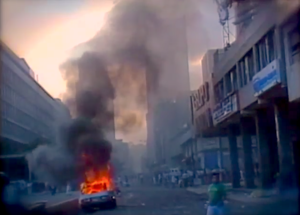1988 Siege of Senora
| Siege of Senora | ||||||||
|---|---|---|---|---|---|---|---|---|
| Part of Movimiento del Gran Rugido Libre uprisings | ||||||||
 Television images of Izalco in the moments the National Guard entered the city. | ||||||||
| ||||||||
| Combatants | ||||||||
|
|
|
| ||||||
| Commanders and leaders | ||||||||
|
|
|
| ||||||
| Strength | ||||||||
|
|
| ||||||
| Casualties and losses | ||||||||
|
|
| 66 autodefensas killed | ||||||
The 1988 Siege of Senora, also known as the Senoran Uprising or the Senoran incursion (Spanish: Asedio de Senora), which engulfed the Rugidoense state of Senora, was a uprising that saw a Federal Military intervention against those loyal to the Movimiento por el Gran Rugido Libre. This revolution marked a significant period in the history of left-wing politics in Gran Rugido and doubted the international community whether Gran Rugido's stability post-1970 would be perpetual or even stable.
The uprising began in the city of Izamal, after members of the MGRL fired upon and beaten government troops. Some citizens took up arms, raiding local police stations and armouries, and were able to take control of large sections of the city before calling for expansion to other Senoran cities. The response by the federal government was swift against the rioters and the militias. Taking experience from past uprisings, the governemnt sweep most FGR offensives of Aztlán, Izamal and Peñuelos. After 24 days of unrest and leftist setbacks that included the formation of the Autodefensas, armed civilian groups, the government alongside the [[777th Legion]] of the National Guard pushed flanks of the leftists and re-entered the city of Izalco, capital of the Separatists. With most of the MGRL leadership captured in the process, the uprising was quelled and these leaders and associates were executed for treason.
At the time, the Rugidoense governemnt reported an estimate 5000 deaths amongst Federal forces, National Guard Members and armed civilians. Civilian casualties are often estimated between 450-800 deaths.
Prelude
After the Gran Rugidoense Civil War destroyed most of the country, people loyal to the Pensamiento de Zavala, (a mixture of Singularism and Socialism) defected the country and avoided capture in the immediate days following the Santa Elisa ceasefire. Rejecting most of the Loyalist government causes and position, the predecessor of the Movimiento por el Gran Rugido Libre was formed. Stigmatization of the left continued as the Rugidoense government continued to suppress instances of political mobilization and social organization as part of what is known as Operación Equilibrio. During the Reconstrucción, several NRP sympathetic organizations as well as small armed groups began to form in Senora through the 1970s. At the same time, many socialist individuals known as guerrilleros formed small armed militant groups in response to persecution, one of which became the MGRL.
After Daniel Figueroa rise to power following the dubious 1986 Gran Rugidoense federal election, the IFE dropped recognition of serveral leftist parties, including the Communist Party of Gran Rugido. Most members of these parties became memebers of the MGRL after they were promised a return to ballots after their takeover. The catalyst for the MGRL's decision to revolt was the arrest of communist leader Lázaro Jaramillo. In the year before the rebellion, the MGRL designated Subcomandante Daniel (Spanish for "Subcommander") as the ideological leader of the uprising and also made plans to declare war on the state of Gran Rugido. Daniel was unique in his leadership because unlike most of the uprising participants, his determination was real and unbreakable. The MGRL declared war on the Rugidoense state on June 15, 1988 to protest Jaramillo's arrest and trial.